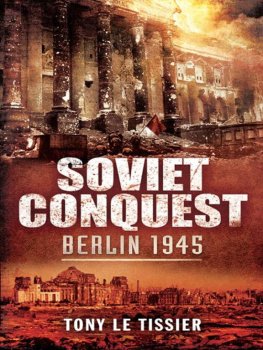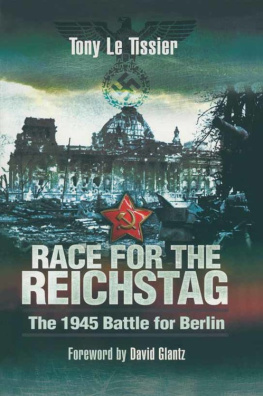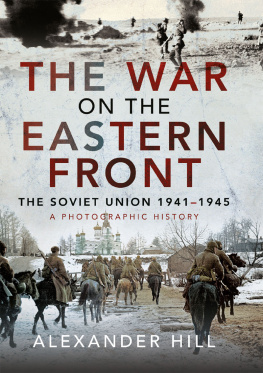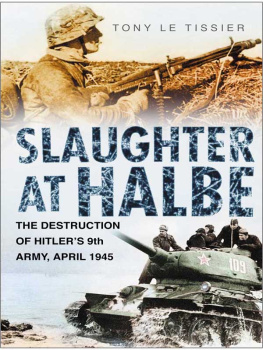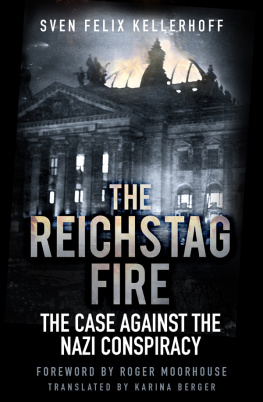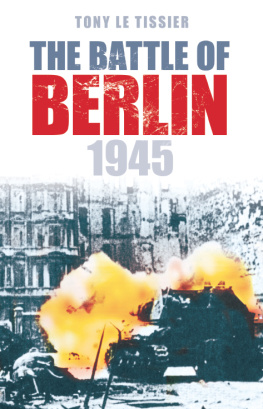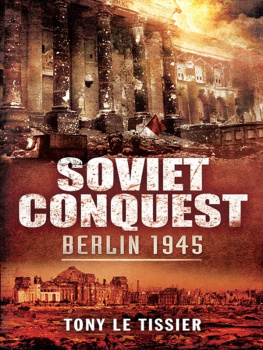We Stormed the Reichstag
A War Correspondent Remembers
Vassili J. Subbotin
Translated by Tony Le Tissier
Published in German as Wir strmten den Reichstag. Aufzeichnungen eines Frontkorrespondenten by Militrverlag in 1980
First published in Great Britain in 2017 by
PEN & SWORD MILITARY
an imprint of
Pen & Sword Books Ltd
47 Church Street
Barnsley
South Yorkshire
S70 2AS
Copyright original text Vassili J. Subbotin
Translation copyright Tony Le Tissier 2016
ISBN 978-1-47387-775-7
eISBN 978-1-47387-777-1
Mobi ISBN 978-1-47387-776-4
The right of Vassili J. Subbotin to be identified as the author of this work has been asserted by him in accordance with the Copyright, Designs and Patents Act 1988.
A CIP catalogue record for this book is available from the British Library.
All rights reserved. No part of this book may be reproduced or transmitted in any form or by any means, electronic or mechanical including photocopying, recording or by any information storage and retrieval system, without permission from the Publisher in writing.
Pen & Sword Books Ltd incorporates the imprints of Pen & Sword Archaeology, Atlas, Aviation, Battleground, Discovery, Family History, History, Maritime, Military, Naval, Politics, Railways, Select, Social History, Transport, True Crime, and Claymore Press, Frontline Books, Leo Cooper, Praetorian Press, Remember When, Seaforth Publishing and Wharncliffe.
For a complete list of Pen & Sword titles please contact
PEN & SWORD BOOKS LIMITED
47 Church Street, Barnsley, South Yorkshire, S70 2AS, England
E-mail:
Website: www.pen-and-sword.co.uk
List of Plates
Soviet guns cover troops charging towards the Reichstag
A Soviet machine-gun team in action
Two Soviet tanks destroyed at the end of the Moltkestrasse
Soviet tanks negotiating a Berlin street
After the battle debris in a Berlin street
Soviet tanks near the Brandenberg Gate
The Soviet flag over the Reichstag
An aerial view of the Reichstag after the battle
Inside the ruined Reichstag
Soviet soldiers inscriptions inside the captured Reichstag
Marshal Zhukov inspects the ruined Reichstag
Soviet tanks outside the Reichstag
An artists impression of the Reichstag victory
Celebrating the taking of the Reichstag
Victorious besiegers pose before their prize
Soviet soldiers inspecting discarded German medal cases
The Brandenberg Gate and Unter den Linden after the battle
A Soviet soldier views the Reichstag
Defeat
Introduction
Vassili Subbotins account of his personal experiences during the Second World War, in which he served as a conscript and finally as a commissioned war correspondent on the newspaper of the 150th Idritz Infantry Division, follows this introduction. It was as a result of this role that he eventually became involved in the storming of the Reichstag and post-war managed to regain contact with some of his former colleagues, revisited Berlin and wrote an account of his experiences.
Although the Reichstag building had been severely damaged in an arson attack by a deranged Dutchman on 27 February 1933, it remained of considerable historic significance to the Soviets and became the prime objective in their attack on Berlin. Following the fire, the German parliament had been transferred some 400m across the park in front of the Reichstag to the Kroll Opera House.
Then in January 1938 it was announced that a new plan existed for the transformation of the city, and on the night of the capitulation of France in 1940 Hitler issued the order that the fulfilment of this plan was to be completed by 1950.
My drawing (p. xviii) describing the Soviet attack on the Reichstag shows the stripped and partially cleared Diplomatic Quarter, the adjacent Ministry of the Interior, the large flooded area in the centre marking the proposed new course for the Spree and the ditch for the connecting underground railway to the proposed Great Hall curving south, together with the outlines of temporary construction site buildings opposite the Kroll Opera House and in front of the Reichstag.
It was on the afternoon of 28 April 1945 that the leading elements of the 79th Rifle Corps advancing along the street known as Alt Moabit first caught sight of the Reichstag building through the swirling clouds of smoke and dust that obscured the central districts of the city. The fixation of the Soviets on the Reichstag as their goal was to highlight this particular part of the battle to heroic proportions. Heroic as it undoubtedly was in its execution, this episode also emphasizes the ruthless exploitation of the troops involved and the fundamental military errors made by their commanders in their haste to meet a politically dictated deadline. The pressure from Stalin downwards to get the Red Flag flying from the top of the Reichstag in time for the May Day celebrations was such that no one in the chain of command wanted to be in a position where he could be accused of sabotaging the project. The cost was of no consequence.
The news created great excitement and Corps Commander Major General S.N. Perevertkin hastened forward to see for himself. He decided to establish his command post in the tall Customs building at the end of the street overlooking the Moltke Bridge and the approaches to the Reichstag. The 150th Rifle Division was already beginning to assemble in the vicinity of the Customs building, and he called forward the 171st Rifle Division to assemble in the ruins of the Lehrter Railway Station on the other side of the street.
Immediately to the left was the Schiffahrts Canal denoting the corps boundary, behind which the Germans were still holding out as far north as Invalidenstrasse. There were also German troops north of the Spree on Perevertkins right in Lehrter Goods Station, which had not been on his line of advance and so remained uncleared. Across his front the river was some 50m wide, the stone quay of the Customs Yard dropping 10ft to the water level in full view of the enemy opposite. The only ready means available for crossing the river was the massive stone-built Moltke Bridge, which was strongly barricaded at either end, ready mined for demolition, strewn with barbed wire and other obstacles, and swept by artillery and machine-gun fire from positions concealed in the buildings on the far bank. Across the bridge on either side of Moltkestrasse were the badly damaged but still standing and heavily fortified buildings of the former Diplomatic Quarter and the Ministry of the Interior. Behind them aerial reconnaissance had revealed the presence of a large flooded pit from which a submerged anti-tank ditch extended right across Knigsplatz in front of a series of trenches and gun emplacements connecting with the Reichstag itself. Further artillery and mortars were entrenched in the Tiergarten and the whole area had been mined. Like the other buildings in the area, the Reichstag had its doors and windows bricked up except for small gunports, and was to prove virtually impervious to shelling. All these buildings had street-level cellar windows providing ready-made gun embrasures, and high in the burnt-out frame of the Reichstag dome were hidden further machine-guns.
The large water obstacle, which would influence the line of attack, was in fact part of the cutting intended for the diversion of the Spree to enable the construction of Albert Speers Great Hall on the north side of the square, the anti-tank ditch being in fact a cutting for a U-Bahn tunnel leading to Moltkestrasse. The tunnel running parallel to Siegesallee had been completed as far north as Knigsplatz before work had been abruptly abandoned two or three years previously, leaving the construction site littered with temporary buildings, all of which had been incorporated into the defence system.


